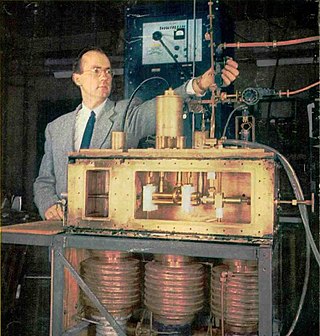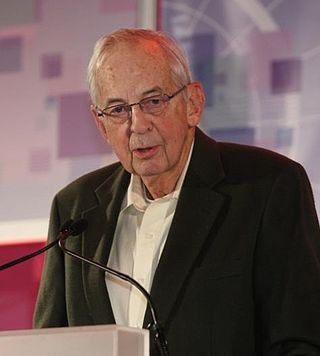Related Research Articles

Laser science or laser physics is a branch of optics that describes the theory and practice of lasers.

A maser is a device that produces coherent electromagnetic waves (microwaves), through amplification by stimulated emission. The term is an acronym for microwave amplification by stimulated emission of radiation. First suggested by Joseph Weber, the first maser was built by Charles H. Townes, James P. Gordon, and Herbert J. Zeiger at Columbia University in 1953. Townes, Nikolay Basov and Alexander Prokhorov were awarded the 1964 Nobel Prize in Physics for theoretical work leading to the maser. Masers are used as the timekeeping device in atomic clocks, and as extremely low-noise microwave amplifiers in radio telescopes and deep-space spacecraft communication ground stations.

Theodore Harold Maiman was an American engineer and physicist who is widely credited with the invention of the laser. Maiman's laser led to the subsequent development of many other types of lasers. The laser was successfully fired on May 16, 1960. In a July 7, 1960, press conference in Manhattan, Maiman and his employer, Hughes Aircraft Company, announced the laser to the world. Maiman was granted a patent for his invention, and he received many awards and honors for his work. His experiences in developing the first laser and subsequent related events are recounted in his book, The Laser Odyssey, later being republished in 2018 under a new title, The Laser Inventor: Memoirs of Theodore H. Maiman.

Polykarp Kusch was a German-born American physicist. In 1955, the Nobel Committee gave a divided Nobel Prize for Physics, with one half going to Kusch for his accurate determination that the magnetic moment of the electron was greater than its theoretical value, thus leading to reconsideration of—and innovations in—quantum electrodynamics.

Charles Hard Townes was an American physicist. Townes worked on the theory and application of the maser, for which he obtained the fundamental patent, and other work in quantum electronics associated with both maser and laser devices. He shared the 1964 Nobel Prize in Physics with Nikolay Basov and Alexander Prokhorov. Townes was an adviser to the United States Government, meeting every US president from Harry S. Truman (1945) to Bill Clinton (1999).

Nicolaas Bloembergen was a Dutch-American physicist and Nobel laureate, recognized for his work in developing driving principles behind nonlinear optics for laser spectroscopy. During his career, he was a professor at Harvard University and later at the University of Arizona and at Leiden University in 1973.

Arthur Leonard Schawlow was an American physicist who, along with Charles Townes, developed the theoretical basis for laser science. His central insight was the use of two mirrors as the resonant cavity to take maser action from microwaves to visible wavelengths. He shared the 1981 Nobel Prize in Physics with Nicolaas Bloembergen and Kai Siegbahn for his work using lasers to determine atomic energy levels with great precision.

Ali Javan ; December 26, 1926 – September 12, 2016) was an Iranian American physicist and inventor. He was the first to propose the concept of the gas laser in 1959 at the Bell Telephone Laboratories. A successful prototype, constructed by him in collaboration with W. R. Bennett, Jr., and D. R. Herriott, was demonstrated in 1960. His other contributions to science have been in the fields of quantum physics and spectroscopy.

Arthur Gordon Webster was an American physicist who founded the American Physical Society.
Dr. Henry Evelyn Derrick Scovil, better known as H. E. D. Scovil or Derrick Scovil (1923-2010), was a physicist noted for his contributions to masers and bubble memory.
Francis Goddard Slack was an American physicist. He was a physics teacher, researcher, and administrator in academia who was renowned for placing equal emphasis on teaching and on research.
G. Norris Glasoe was an American nuclear physicist. He was a member of the Columbia University team which was the first in the United States to verify the European discovery of the nuclear fission of uranium via neutron bombardment. During World War II, he worked at the MIT Radiation Laboratory. He was a physicist and administrator at the Brookhaven National Laboratory.
Isaac David Abella was a Canadian physicist who was a professor at the University of Chicago. He specialized in laser physics, quantum optics, and spectroscopy. Isaac was the cousin of Irving Abella.
A molecular beam is produced by allowing a gas at higher pressure to expand through a small orifice into a chamber at lower pressure to form a beam of particles moving at approximately equal velocities, with very few collisions between the particles. Molecular beams are useful for fabricating thin films in molecular beam epitaxy and artificial structures such as quantum wells, quantum wires, and quantum dots. Molecular beams have also been applied as crossed molecular beams. The molecules in the molecular beam can be manipulated by electrical fields and magnetic fields. Molecules can be decelerated in a Stark decelerator or in a Zeeman slower.

David Jeffery Wineland(born February 24, 1944) is an American Nobel-laureate physicist at the National Institute of Standards and Technology (NIST). His work has included advances in optics, specifically laser-cooling trapped ions and using ions for quantum-computing operations. He was awarded the 2012 Nobel Prize in Physics, jointly with Serge Haroche, for "ground-breaking experimental methods that enable measuring and manipulation of individual quantum systems".

James Power Gordon was an American physicist known for his work in the fields of optics and quantum electronics. His contributions include the design, analysis and construction of the first maser in 1954 as a doctoral student at Columbia University under the supervision of C. H. Townes, development of the quantal equivalent of Shannon's information capacity formula in 1962, development of the theory for the diffusion of atoms in an optical trap in 1980, and the discovery of what is now known as the Gordon-Haus effect in soliton transmission, together with H. A. Haus in 1986. Gordon was a member of the National Academy of Engineering and the National Academy of Sciences.
Edward Allan Frieman was an American physicist who worked on plasma physics and nuclear fusion. He was the director of the Scripps Institution of Oceanography from 1986 through 1996, and then the senior vice president of science and technology at the Science Applications International Corporation from 1996 on until his death in 2013.
Herbert Leopold Strauss was an American chemist who specialized in spectroscopy. His family fled Nazi Germany and eventually immigrated to New York, where he graduated from Columbia University. He spent the entirety of his career at the University of California, Berkeley.
Kathryn A. McCarthy was an American physicist who studied "the physical, optical and thermal properties of optical crystalline materials", became the youngest faculty member ever hired at Tufts University and, later, became the first woman to serve as provost at Tufts.
Alexander Luis Gaeta is an American physicist and the David M. Rickey Professor of Applied Physics at Columbia University. He is known for his work on quantum and nonlinear photonics. He is a Fellow of the American Physical Society, Optica, and of the Institute of Electrical and Electronics Engineers.
References
- 1 2 3 "Herbert Zeiger Obituary - Boston, MA | Boston Globe". Legacy.com. Boston Globe - accessed online through Legacy.com, a subsidiary of Ancestry.com. 15 Jan 2011. Retrieved 30 Sep 2019.
- 1 2 Gordon, James; Zeiger, Herbert; Townes, Charles (15 Aug 1955). "The Maser - New Type of Microwave Amplifier, Frequency Standard, and Spectrometer". Physical Review. 99 (4). American Physical Society: 1264–1274. Bibcode:1955PhRv...99.1264G. doi: 10.1103/PhysRev.99.1264 .
- ↑ "APS Fellow Archive". APS. American Physical Society. 2019. Retrieved 30 Sep 2019.
- ↑ "Charles Hard Townes Award". OSA. The Optical Society. 2019. Retrieved 30 Sep 2019.